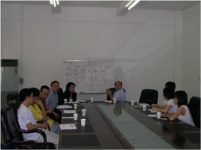
Introduction to the pilot application of RFID in Meichen Additives Company
[ad_1]
Meichen Group Additive Company is located in the south of Huadi Avenue, Liwan District, Guangzhou, and is one of the leaders in China’s additive industry. Its products include cake oil, bread improver and many other series.
Batch management is an important part of food storage. Since foods have a very short lifespan, the warehouse management must be carried out on a strict “first in first out” principle to reduce the loss caused by product expiration. Aiming at the operation process of Meichen Group Additive Company, the Electronic Commerce Technology Institute (ETI) of the University of Hong Kong (HKU) and the Modern Logistics Technology and Management Research Center of Sun Yat-sen University introduced RFID technology in June 2006 to assist in improving its product batch management level.
In a nutshell, in this pilot project, when the product is in the warehouse, we use an RFID tag to associate the type, quantity, and batch of each board of the product in the warehouse, and record its location in the warehouse. When the product is out of the warehouse, you can pick the goods at the designated location based on the type, batch, and quantity of the product, and check whether the outgoing product is the designated product through the RFID tag affixed to each board at the warehouse door. The product.
Specifically, when the product is offline from the production workshop, the production department personnel enter the relevant information into the company’s SAP system. At the same time, the warehouse management department will receive instructions for product storage. The warehouse management department will insert an RFID tag on each pallet according to the quantity of the product. Afterwards, you can turn on the RFID system, import production orders from the SAP system, and prepare the products for storage. When the product is transported from the production workshop to the warehouse, the RFID system will first detect an RFID tag assigned to each board. At the same time, other information of the board cargo, including product name, quantity, batch, storage time, etc., is associated in the system. After the products are put into the warehouse, the high fork driver puts the goods in the appropriate position in the warehouse and records the specific location of each board. After finishing all the shelves, hand over the location record form of the goods to the RFID system operator. The RFID system operator records the detailed position of the pallet in the RFID system. After the warehousing operation is completed, the warehouse management personnel can check the quantity and location of the warehousing products.
When the product needs to be shipped out, the warehouse manager will import the outbound product information from SAP according to the outbound order and the delivery note. And the RFID system generates a picking list according to the product batch, quantity and location. The high fork driver picks the goods from the designated location according to the picking list. When the forklift driver transports the goods out of the warehouse, when passing the warehouse door, the RFID system can detect the RFID tag on each board, and then confirm whether the board goods are the designated goods. . If it is, a confirmation message will be given; if it is not, a warning message will be given. After the outbound operation is completed. The warehouse management personnel can check the quantity, batch, location, etc. of the products out of the warehouse. At the same time, you can also query the quantity and location of products in the entire warehouse, so that warehouse managers can know the storage situation of the warehouse in real time.
Generally speaking, the RFID system can make it easier for warehouse managers to clearly know the quantity and stacking position of different batches of products in the warehouse, ensuring the “first in, first out” principle, and avoiding losses due to missing products out of the warehouse. The batch and fast processing brought by RFID technology not only ensures the efficiency of warehouse entry and exit, but also improves the accuracy of warehouse entry and exit.
For more detailed information, please email to [email protected]
Appendix: Project Memorabilia
1. June 2006: Start the project plan demonstration

2. September 2006: Hardware equipment installation

3. October 2006: System test

4. November 2006: System operation

This article is the author’s original submission. The copyright of the article belongs to the author. If you want to reprint it, you must obtain the author’s consent. thanks!
[ad_2]



